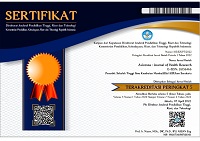PROBIOTIK UNTUK KEHAMILAN : A REVIEW
Abstract
Tujuan: Mengulas manfaat probiotik untuk kehamilan dan kesehatan wanita. Metode: Review ini dilakukan penulis dengan menelusuri database diantaranya PubMed, Google scholar, dan open access science direct untuk mengetahui potensi studi yang memenuhi syarat. Kata kunci yang digunakan antara lain: ‘Probiotic for pregnancy 'ATAU' ‘Probiotic AND hypertension AND Prenancy’ ATAU Probiotic AND Diabetus mellitus” ATAU ‘ Probiotic AND Pregnancy AND Review’. Penelusuran ini dilakukan mulai dari Februari hingga Maret 2020 Hasil: Bakteri jenis Lactobacillus dan Bifidobacterium dapat mengobati dan mencegah bakterial vainosis dengan memproduksi zat antibakteri antara lain reutericyclin, asam organik, bakteriosin, reuterin dan hidrogen peroksida. Hidrogen peroksida (H2O2). Bakteri jenis Streptococcus, Escherichia, Lactobacillus, dan Bifidobacterium dapat mensintesis neurotransmiter dalam sistem saraf otonom, mengubah tonus pembuluh darah, mengubah fungsi endotel, dan memproduksi asam lemak / Short Chain Fatty Acid (SCFA) untuk menurunkan tekanan darah. Selain itu Lactobacillus rhamnosus GG dan Bifidobacterium lactis BB12 dilaporkan dapat menurunkan kdar insulin dan risiko GDM
Simpulan: Probiotik merupakan mikroba normal yang ada di dalam tubuh, sehingga penambahan dan penggunaannya dalam terapi dapat dipertimbangkan. Belum dilaporkan adanya efek samping berarti dari penggunaan probiotik dalam jangka panjang ataupun pendek, sehingga alternatif terapi probiotik sangat diperhitungkan untuk diberikan pada ibu hamil.
Full Text:
PDF (Bahasa Indonesia)References
Aidy, S. El, Dinan, T. G. and Cryan, J. F. (2014) ‘Immune modulation of the brain-gut-microbe axis’, Frontiers in Microbiology. doi: 10.3389/fmicb.2014.00146.
Cani, P. D. and Delzenne, N. M. (2007) ‘Gut microflora as a target for energy and metabolic homeostasis’, Current Opinion in Clinical Nutrition and Metabolic Care. doi: 10.1097/MCO.0b013e3282efdebb.
Darmayanti, A.T, Murti, B, Susilawati T.N. (2017) ‘The Effectiveness of Adding Probiotic on Antimicrobial for Bacterial Vaginosis: A Systematic Review’, Indonesian Journal of Medicine, 02(03), pp. 161–168. doi: 10.26911/theijmed.2017.02.03.03
Gomez-Arango, L. F. et al. (2016) ‘Increased Systolic and Diastolic Blood Pressure is Associated with Altered Gut Microbiota Composition and Butyrate Production in Early Pregnancy’, Hypertension, 68(4), pp. 974–981. doi: 10.1161/HYPERTENSIONAHA.116.07910.
Halkjaer, S. I. et al. (2016) ‘Effects of probiotics (Vivomixx®) in obese pregnant women and their newborn: Study protocol for a randomized controlled trial’, Trials. Trials, 17(1), pp. 1–9. doi: 10.1186/s13063-016-1617-5.
Hou, C. et al. (2015) ‘Study and use of the probiotic Lactobacillus reuteri in pigs: a review’, Journal of Animal Science and Biotechnology, 6(1), p. 14. doi: 10.1186/s40104-015-0014-3.
Jandhyala, S. M. et al. (2015) ‘Role of the normal gut microbiota’, World Journal of Gastroenterology, 21(29), pp. 8836–8847. doi: 10.3748/wjg.v21.i29.8787.
Krauss-Silva, L. et al. (2011) ‘A randomised controlled trial of probiotics for the prevention of spontaneous preterm delivery associated with bacterial vaginosis: preliminary results’, Trials. BioMed Central Ltd, 12(1), p. 239. doi: 10.1186/1745-6215-12-239.
Lindsay, K. L. et al. (2013) ‘Probiotics in pregnancy and maternal outcomes: A systematic review’, Journal of Maternal-Fetal and Neonatal Medicine, 26(8), pp. 772–778. doi: 10.3109/14767058.2012.755166.
Luoto, R. et al. (2010) ‘Impact of maternal probiotic-supplemented dietary counselling on pregnancy outcome and prenatal and postnatal growth: A double-blind, placebo-controlled study’, British Journal of Nutrition. doi: 10.1017/S0007114509993898.
Lyte, M. (2011) ‘Probiotics function mechanistically as delivery vehicles for neuroactive compounds: Microbial endocrinology in the design and use of probiotics’, BioEssays. doi: 10.1002/bies.201100024.
Pelzer, E. et al. (2017) ‘Review: Maternal health and the placental microbiome’, Placenta. Elsevier Ltd, 54, pp. 30–37. doi: 10.1016/j.placenta.2016.12.003.
Tilg, H. and Kaser, A. (2011) ‘Gut microbiome, obesity, and metabolic dysfunction’, Journal of Clinical Investigation. doi: 10.1172/JCI58109.
Tri Darmayanti, A., Nugraha Susilawati, T. and Murti, B. (2019) ‘Giving Probiotic for a Better Therapy of Bacterial Vaginosis’, KnE Life Sciences, 4(12), p. 239. doi: 10.18502/kls.v4i12.4179.
Vujic, G. et al. (2013) ‘Efficacy of orally applied probiotic capsules for bacterial vaginosis and other vaginal infections: A double-blind, randomized, placebo-controlled study’, European Journal of Obstetrics Gynecology and Reproductive Biology. Elsevier Ireland Ltd, 168(1), pp. 75–79. doi: 10.1016/j.ejogrb.2012.12.031.
Yang, T. et al. (2015) ‘Gut Dysbiosis is Linked to Hypertension’, Hypertension. doi: 10.1161/HYPERTENSIONAHA.115.05315.
DOI: https://doi.org/10.36419/avicenna.v3i1.346
Avicenna : Journal of Health is published by Sekolah Tinggi Ilmu Kesehatan Mamba’ul ‘Ulum Surakarta.
Jl. Ring Road No.Km 03, Mojosongo, Kec. Jebres, Kota Surakarta, Jawa Tengah 57127 | email : info@stikesmus.ac.id | web : www.stikesmus.ac.id
Avicenna : Journal of Health is licensed under a Lisensi Creative Commons Atribusi-BerbagiSerupa 4.0 Internasional |







